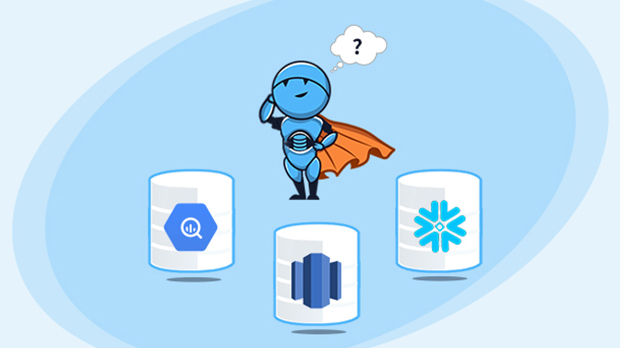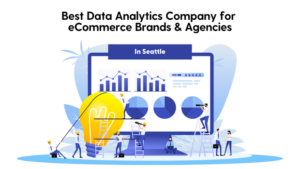Modern businesses, across the globe, are using cloud data warehouses as a foundation for effective data analysis and business intelligence. A cloud data warehouse eliminates the maintenance of internal hardware and infrastructure. Popular cloud data warehouses are Amazon Redshift, Google BigQuery, Microsoft Azure SQL, and Snowflake.
Choosing the right cloud data warehouse becomes challenging for organizations due to a varied number of factors guiding it. One needs to be thoroughly aware of the key features of the cloud data warehouses and the criteria to evaluate them.
Common Features of Cloud Data Warehouses
All the popular cloud data warehouse providers in the market, offer the following core functionalities:
Reliability
The data warehouses are not immune to failures despite having historically high uptime. Errors periodically cause downtime and make the warehouse unavailable. A data-driven organization relies on the critical processes in the data warehouse; hence reliability is of paramount importance. The popular cloud data warehouse providers support features like data replication across data centers and regions for enhancing reliability.
Scalability
Another vital feature that is expected from any data warehouse is the flexibility of storage and computing resources. Massive parallel processing (MPP) systems power the major cloud data warehouses, enabling them to scale up when computing demands are high and down to reduce costs when demands are lower.
Columnar Data Storage
Records are stored in columnar format rather than by row in any cloud data warehouse. This type of storage optimizes the data for compression, reducing the number of disks seeks on queries.
Popular Cloud Data Warehouses
The popular cloud data warehouse vendors meet enterprise demands for cloud computing and big data processing.
Amazon Redshift
Amazon Web Services ( AWS) is the very first public cloud provider to offer a cloud-based, petabyte-scale data warehousing service. The service is called Amazon Redshift. Redshift is today’s most widely used cloud data warehouse and commands a leading position in the cloud data warehousing segment. Redshift boasts thousands of small and large companies as its customers. However, competition in this space is now heating up with Amazon Redshift, Snowflake, and Oracle Autonomous Data Warehouse competing for a share in the growing data warehouse space.
Since early 2013, Amazon Redshift has been around and has undergone many improvements over the past six years. Built on Postgres, the software provides a query engine familiar to most users, allowing SQL-based queries. Although AWS fully supports the infrastructure underpinning Amazon Redshift, some functions would still need to be managed by Amazon Redshift administrators. Amazon Redshift tools, however, make this management a breeze.
Built on a scalable infrastructure, Amazon Redshift supports big data and massive workloads spanning many nodes and multiple petabytes of data. Amazon Redshift also provides a robust data load management console, allows connections from any SQL client, and supports a host of business intelligence tools to connect to the service. Amazon Redshift also supports REST APIs enabling developers to manage the instance in real-time with simple API calls.
Amazon Redshift Spectrum, AWS Athena, and the omnipresent Amazon S3 data storage solution complement Amazon Redshift and collectively offer all the necessary technologies to build a data warehouse or data lake. Pricing any cloud service requires a deep software and architecture know-how understanding, and Amazon Redshift is no different. Sometimes people may be misled by the ease of using these services but may be surprised at the end of the month when the invoices appear, and the amount due is more than their original service account.
Billing surprises are not unique to AWS, and that is how the cloud works; just because spinning up services is simple in the cloud does not mean you do not need to focus on specifics – would not it be nice if these services were optimized for performance and price? Well, that is another day’s topic. The good news is that Redshift can fit both your technical and budget requirements. It often wins benchmarks for performance and cost-efficiency on standard data analytics workflows.
Google BigQuery
Google BigQuery is the first genuinely serverless data warehouse-as-a-service offering in the market. There is no infrastructure to manage, no patches to apply, or any upgrades to be made. The role of a database administrator in a Google BigQuery environment is to architect the schema and optimize the partitions for performance and cost. This cloud service automatically scales to fulfil the demands of any query without the need for intervention by a database administrator. Google BigQuery service also introduced an unusual pricing model that is based not on the storage capacity or the compute capacity needed to process your queries. Instead, the pricing relies on the amount of data processed by incoming queries.
The best part about Google BigQuery is that you can load data to the service and start using the data immediately. Users no longer have to worry about what runs under the hood because the implementation details are hidden from them. All you need is a mechanism to load data into Google BigQuery and the ability to write SQL queries. By making data warehousing so simple, Google BigQuery has revolutionized the cloud data warehousing space and has put the power back in the hands of the analysts.
It is good practice to understand the architecture of Google BigQuery. Understanding the architecture helps control costs, query performance, and storage. The factors that govern Google BigQuery Pricing are Storage and Query Data Processed.
Microsoft Azure SQL
Microsoft is popular for its SQL Server database. But they also offer a competitive cloud data warehouse platform. Azure SQL Data Warehouse provides a scalable and cost-effective system for processing extensive datasets with standard syntax and interfaces. Azure’s data warehouse offers more control over indexing than its competitors. You need to be technically sound to optimize the underlying data structures in Azure. It allows teams with strong SQL skills to manage their data-driven systems effectively.
Snowflake
Snowflake is a cloud-based data warehouse created by three data warehousing experts at Oracle Corporation in 2012. Snowflake Computing, the vendor behind the Snowflake Cloud Data Warehouse product, raised over $400 million over the past eight years and acquired thousands of customers. One might wonder if another data warehouse vendor is needed in an already crowded field of traditional data warehousing technologies like Oracle, Teradata, SQL Server, and cloud data warehouses like Amazon Redshift and Google BigQuery. Well, the answer is the disruption caused by cloud technologies and cloud opportunities for new technology companies. Public clouds enabled startups to shed past baggage, learn from the past, challenge the status quo, and take a fresh look at cloud opportunities to create a new data warehouse product. You can read this article to understand the core technology components that make up this modern, cloud-built data warehouse for consumers of cloud technologies.
You can register for a $400 free trial of Snowflake within minutes. This credit is sufficient to store a terabyte of data and run a small data warehouse environment for a few days.
5 Simple Steps to Choose the Right Data Warehouse
Though the cloud data warehouses offer similar functionalities, there are essential factors that your company needs to consider before choosing the right platform for your business:
1. Business needs
Cloud data warehouses are designed for different industries and business departments. Yet, you should carefully consider how to use your data warehouse service based on the use case and your business needs.
For instance, Snowflake is perfect for those who work with JSON in its data warehouse. Businesses without a dedicated data administrator should not prefer Redshift, which requires configuration and regular monitoring.
2. Security
Select a data warehouse that supports the type of security your business needs. Most of data warehouse vendors keep their security systems updated and patch vulnerabilities. Yet there might be a default system configuration which will become your concern. Let us take the example of Google BigQuery, which encrypts data at rest and in transit by default. Whereas, Amazon Redshift requires database encryption to be explicitly enabled.
3. Internal Technical Feature
Cloud data warehouses differ based on data requirements. Snowflake supports semi-structured data in structures like Object or Array, but Redshift does not. Hence, Redshift can make stronger assumptions about the data structure, which affects the choice of compression schemes and better optimize its storage speed.
4. Resource Bundling and Billing
Many cloud data warehouse vendors bundle resources and calculate costs. Amazon Redshift bundles storage and computes resources together. So, they can offer simple pricing plans. Google BigQuery has a more granular pricing structure. It charges for bytes read, stored, and streaming inserted. Microsoft’s data warehouse bundles the lower-level technical factors of the cost related to computing. Logical CPU cores and I/O will be consolidated into a “Data Warehouse Unit” (DWU). Snowflake also extracts physical resources into credits, which increase proportionally with the number of virtual warehouses and the number of resources within each.
Ask these questions before selecting a service provider that will help you calculate expected utilization and make an informed decision:
- How much data do you need to integrate each month?
- What is the frequency of updates to the data?
- What is the frequency of the analytics jobs that you run?
- How much data does the analytics job read?
5. The ecosystem
Before choosing the right data warehouse for your organization, thoroughly understand the ecosystem where existing data and records are present. If, for example, the majority of data is already present in S3, use Redshift or Snowflake on AWS to enhance performance.
Choose the best cloud data warehouse for Your Business
Choosing the best cloud data warehouse for your business can be overwhelming, as many variables can impact the successful deployment of a system. Despite this, by considering expected use cases and workflows, an enterprise can evaluate the relevant factors and select the warehouse that best fits its needs.
Daton is an automated data pipeline that extracts from multiple sources to data lakes or cloud data warehouses like Snowflake, Google Bigquery, Amazon Redshift where employees can use it for business intelligence and data analytics. The best part is that Daton is easy to set up without the need for any coding experience and it is the cheapest data pipeline available in the market.













